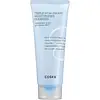What's inside
What's inside
 Key Ingredients
Key Ingredients

No key ingredients
 Benefits
Benefits

 Concerns
Concerns

 Ingredients Side-by-side
Ingredients Side-by-side

Water
Skin ConditioningGlycerin
HumectantStearic Acid
CleansingMyristic Acid
CleansingLauric Acid
CleansingPotassium Hydroxide
BufferingPalmitic Acid
EmollientPotassium Cocoyl Glycinate
Coco-Glucoside
CleansingGlyceryl Stearate
EmollientParfum
MaskingPolyquaternium-7
Acrylates/C10-30 Alkyl Acrylate Crosspolymer
Emulsion StabilisingSodium Cocoyl Isethionate
CleansingArachidic Acid
CleansingDisodium EDTA
1,2-Hexanediol
Skin ConditioningOleic Acid
EmollientSodium Benzoate
MaskingQuillaja Saponaria Bark Extract
CleansingCitric Acid
BufferingButylene Glycol
HumectantPanthenol
Skin ConditioningHyaluronic Acid
HumectantEthylhexylglycerin
Skin ConditioningHydrolyzed Hyaluronic Acid
HumectantSodium Hyaluronate
HumectantWater, Glycerin, Stearic Acid, Myristic Acid, Lauric Acid, Potassium Hydroxide, Palmitic Acid, Potassium Cocoyl Glycinate, Coco-Glucoside, Glyceryl Stearate, Parfum, Polyquaternium-7, Acrylates/C10-30 Alkyl Acrylate Crosspolymer, Sodium Cocoyl Isethionate, Arachidic Acid, Disodium EDTA, 1,2-Hexanediol, Oleic Acid, Sodium Benzoate, Quillaja Saponaria Bark Extract, Citric Acid, Butylene Glycol, Panthenol, Hyaluronic Acid, Ethylhexylglycerin, Hydrolyzed Hyaluronic Acid, Sodium Hyaluronate
Water
Skin ConditioningSodium Cocoyl Isethionate
CleansingGlyceryl Stearate Se
EmulsifyingHydroxypropyl Starch Phosphate
Cocos Nucifera Oil
MaskingDecyl Glucoside
CleansingGlyceryl Oleate
EmollientGlycerin
HumectantPaeonia Lactiflora Root Extract
Skin ConditioningChamomilla Recutita Flower Extract
MaskingAnthemis Nobilis Flower Oil
MaskingRubus Fruticosus Fruit Extract
AstringentEuterpe Oleracea Fruit Extract
Rosa Canina Fruit Extract
AstringentCalendula Officinalis Flower Extract
MaskingAspalathus Linearis Leaf Extract
Skin ConditioningPunica Granatum Extract
AstringentArgania Spinosa Callus Culture Extract
Skin ConditioningJojoba Esters
EmollientHydrolyzed Jojoba Esters
Skin ConditioningLecithin
EmollientIsomalt
HumectantSclerotium Gum
Emulsion StabilisingGlycerophosphoinositol Lysine
Glyceryl Caprylate
EmollientDisodium Coco-Glucoside Citrate
EmulsifyingSodium Lauroyl Lactylate
EmulsifyingEthylhexylglycerin
Skin ConditioningPhenethyl Alcohol
MaskingWater, Sodium Cocoyl Isethionate, Glyceryl Stearate Se, Hydroxypropyl Starch Phosphate, Cocos Nucifera Oil, Decyl Glucoside, Glyceryl Oleate, Glycerin, Paeonia Lactiflora Root Extract, Chamomilla Recutita Flower Extract, Anthemis Nobilis Flower Oil, Rubus Fruticosus Fruit Extract, Euterpe Oleracea Fruit Extract, Rosa Canina Fruit Extract, Calendula Officinalis Flower Extract, Aspalathus Linearis Leaf Extract, Punica Granatum Extract, Argania Spinosa Callus Culture Extract, Jojoba Esters, Hydrolyzed Jojoba Esters, Lecithin, Isomalt, Sclerotium Gum, Glycerophosphoinositol Lysine, Glyceryl Caprylate, Disodium Coco-Glucoside Citrate, Sodium Lauroyl Lactylate, Ethylhexylglycerin, Phenethyl Alcohol
 Reviews
Reviews

Alternatives
Ingredients Explained
These ingredients are found in both products.
Ingredients higher up in an ingredient list are typically present in a larger amount.
Ethylhexylglycerin (we can't pronounce this either) is commonly used as a preservative and skin softener. It is derived from glyceryl.
You might see Ethylhexylglycerin often paired with other preservatives such as phenoxyethanol. Ethylhexylglycerin has been found to increase the effectiveness of these other preservatives.
Glycerin is already naturally found in your skin. It helps moisturize and protect your skin.
A study from 2016 found glycerin to be more effective as a humectant than AHAs and hyaluronic acid.
As a humectant, it helps the skin stay hydrated by pulling moisture to your skin. The low molecular weight of glycerin allows it to pull moisture into the deeper layers of your skin.
Hydrated skin improves your skin barrier; Your skin barrier helps protect against irritants and bacteria.
Glycerin has also been found to have antimicrobial and antiviral properties. Due to these properties, glycerin is often used in wound and burn treatments.
In cosmetics, glycerin is usually derived from plants such as soybean or palm. However, it can also be sourced from animals, such as tallow or animal fat.
This ingredient is organic, colorless, odorless, and non-toxic.
Glycerin is the name for this ingredient in American English. British English uses Glycerol/Glycerine.
Learn more about GlycerinSodium cocoyl isethionate is a natural ingredient from coconut oil. It is an ultra gentle cleanser that gives a nice foam without drying the skin or impacting the skin barrier.
The amount of foam created depends on the amount of sodium cocoyl isethionate used in the product.
This ingredient also helps improve the spreadability of a product.
Learn more about Sodium Cocoyl IsethionateWater. It's the most common cosmetic ingredient of all. You'll usually see it at the top of ingredient lists, meaning that it makes up the largest part of the product.
So why is it so popular? Water most often acts as a solvent - this means that it helps dissolve other ingredients into the formulation.
You'll also recognize water as that liquid we all need to stay alive. If you see this, drink a glass of water. Stay hydrated!
Learn more about Water